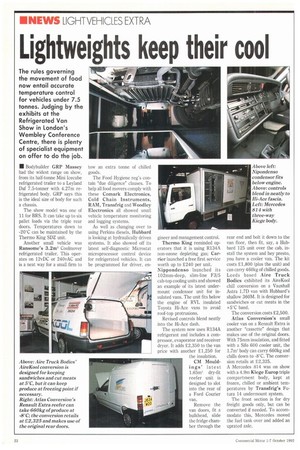Lightweights keep their cool
Page 24

If you've noticed an error in this article please click here to report it so we can fix it.
The rules governing the movement of food now entail accurate temperature control for vehicles under 7.5 tonnes. Judging by the exhibits at the Refrigerated Van Show in London's Wembley Conference Centre, there is plenty of specialist equipment on offer to do the job.
• Bodybuilder GRP Massey had the widest range on show, from its half-tonne Mini Icecube refrigerated trailer to a Leyland Daf 7.5-tonner with 4.27m refrigerated body. GRP says this is the ideal size of body for such a chassis.
The show model was one of 11 for BRS. It can take up to six pallet loads via the triple rear doors. Temperatures down to -20°C can be maintained by the Thermo King SDZ unit.
Another small vehicle was Ransome's 3.2m3 Coolmover refrigerated trailer. This operates on 12vDC or 240vAC and is a neat way for a small firm to
tow an extra tonne of chilled goods.
The Food Hygiene reg's contain 'due diligence" clauses. To help all food movers comply with these Comark Electronics, Cold Chain Instruments, RAM, Transfrig and Woodley Electronics all showed small vehicle temperature monitoring and logging systems.
As well as changing over to using Perkins diesels, Hubbard is looking at hydraulically driven systems. It also showed off its latest self-diagnostic Microstat microprocessor control device for refrigerated vehicles. It can be programmed for driver, en
gineer and management control.
Thermo King reminded operators that it is using R134A non-ozone depleting gas; Carrier launched a free first service worth up to £240 per unit. Nippondenso launched its 102mm-deep, slim-line F3/5 cab-top cooling units and showed an example of its latest undermount condensor unit for insulated vans. The unit fits below the engine of RVL insulated Toyota Hi-Ace vans to avoid roof-top protrusions.
Revised controls blend neatly into the Hi-Ace dash.
The system now uses R134A refrigerant and includes a compressor, evaporator and receiver dryer. It adds £2,350 to the van price with another £1,250 for the insulation.
CM Mouldings' latest 1.65m3 dry-fit reefer unit is designed to slot into the rear of a Ford Courier van.
Remove the van doors, fit a bulkhead, slide the fridge chamber through the
rear end and bolt it down to the van floor, then fit, say, a Hubbard 125 unit over the cab, install the system and hey presto, you have a cooler van. The kit costs £1,800 (plus the unit) and can carry 460kg of chilled goods. Leeds based Aire Truck Bodies exhibited its AireKool chill conversion on a Vauxhall Astra 1.7D van with Hubbard's shallow 360M. It is designed for sandwiches or cut meats in the +5°C band.
The conversion costs £2,500.
Atlas Conversion's small cooler van on a Renault Extra is another "cassette" design that makes use of the original doors. With 75mm insulation, and fitted with a Sifo 600 cooler unit, the 1.7in body can carry 660kg and chills down to -8°C. The conversion retails at £2,325.
A Mercedes 814 was on show with a 4.9m Klege Europ triple compartment body, kept at frozen, chilled or ambient temperatures by Transfrig's Futura 14 undermount system.
The front section is for dry freight goods only, but can be converted if needed. To accommodate this, Mercedes moved the fuel tank over and added an uprated axle.
















































































